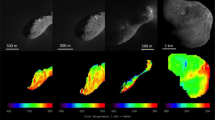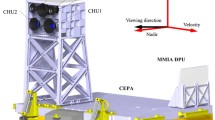Abstract
The capability to measure nearly simultaneously the entire spectrum of atmospheric emission from the extreme ultraviolet to the near infrared, with relatively high spectral resolution and high sensitivity, while also obtaining global and altitude coverage, would provide a database from which significant advances could be made in our current understanding of the atmosphere and its processes. The large payload capacity of the shuttle orbiter offers the first opportunity to put such instrumentation into space. The Imaging Spectrometric Observatory (ISO) comprises an array of five spectrometers designed to make full use of the shuttle as an observing platform for remote sensing of the atmosphere. ISO covers the wavelength range 300–12000 Å at 2–7 Å resolution. Use of area array detectors (intensified-CCD's) permits simultaneous measurements of ∼1000 Å at a time. The instrument is capable of scanning the entire wavelength range in less than 20 s, or dwelling on weaker features for longer periods of time. The detectors are two dimensional and permit spectral imaging in one direction and spatial imaging in the other. The spatial imaging and spatial scanning features permit measurement of altitude profiles, or mapping of strongly spatially varying features such as aurorae. The instrument is designed to allow versatility. The various functions are programmable and software controlled. The key subsystems are modular for convenient replacement or upgrading. It is anticipated that the instrument will have applications not only in the area of atmospheric science, but also in studies of the ionosphere and magnetosphere, and in support of active experiments to be performed in space.
Similar content being viewed by others
References
Acton, L. W., Joki, E. G., and Salman, R. L.: 1976,Space Sci. Instrum. 2, 159.
Basedow, R. W. and Torr, M. R.: 1982,Ground-Based Imaging Spectroscopy of the Thermosphere, Proceedings of the Tenth Annual Meeting on the Study of the Atmosphere by Optical Methods, Grasse, France, September 1982.
Blake, R. L., Santos, P. F., Barros, D. M., Brubakes, W., Fenimore, E., and Puetter, R.: 1976,Space Sci. Instrum. 2, 171.
Leinert, C. and Kluppelberg, D.: 1974,Appl. Opt. 13, 556.
Loewen, E. G. and Neviere, M.: 1978,Appl. Opt. 17, 1087.
Pribram, J. K. and Penchina, C. M.: 1968,Appl. Opt. 7, 2005.
Torr, M. R.: 1980, ‘Intercalibration of Instrumentation Used in the Observation of Atmospheric Emissions: A Progress Report, 1976–1979’. Center for Atmospheric and Space Science, Report No. 100.
Torr, M. R. and Devlin, J.: 1982, Intensified Charge Coupled Devices for Use as a Spaceborne Spectrographic Image Plane Detector System’,Appl. Opt. 21, 3091.
Torr, M. R. and Vitz, R.: 1982, ‘An Extreme Ultraviolet Spectrometer for Thermospheric Emissions’,Appl. Opt. 21, 3080.
Torr, M. R., Baldridge, T. W., and Baum, R. K.: 1982, ‘A Dedicated Control and Data Processor for a Spacelab Imaging Spectrometer Array’,J. Phys. E. Sci. Instrumentation (submitted).
Torr, M. R., Basedow, R. W., and Torr, D. G.: 1982, ‘Imaging Spectroscopy of the Thermosphere from the Space-Shuttle’,Appl. Opt. 21, 4130.
Author information
Authors and Affiliations
Rights and permissions
About this article
Cite this article
Torr, M.R., Basedow, R.W. & Mount, J. An imaging spectrometric observatory for spacelab. Astrophys Space Sci 92, 237–291 (1983). https://doi.org/10.1007/BF00651293
Received:
Revised:
Issue Date:
DOI: https://doi.org/10.1007/BF00651293




